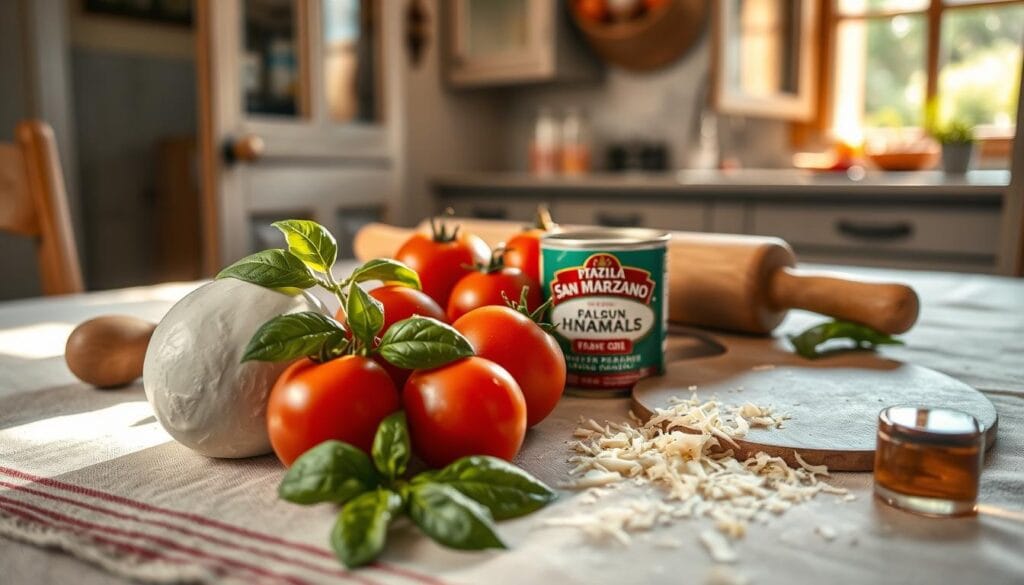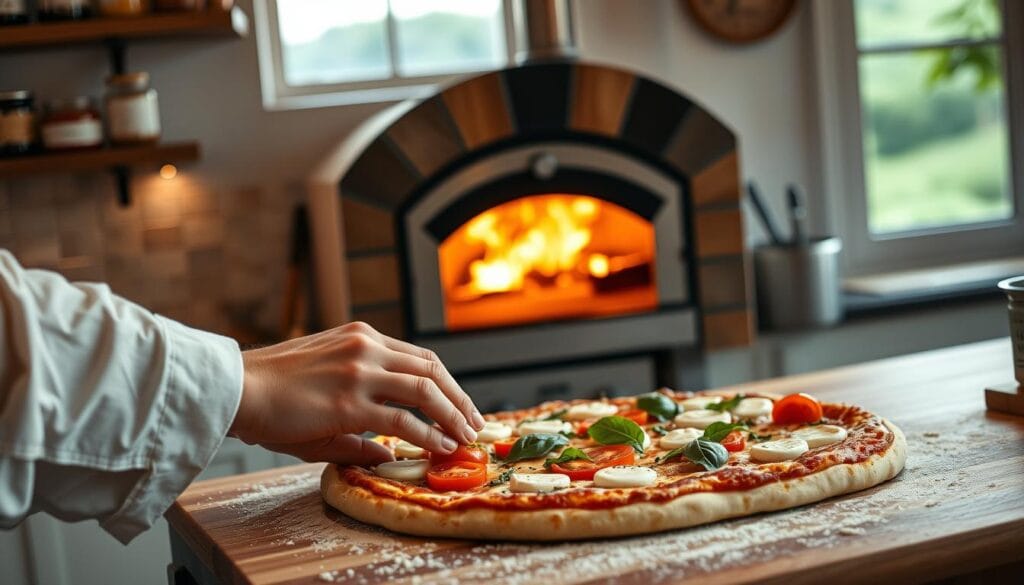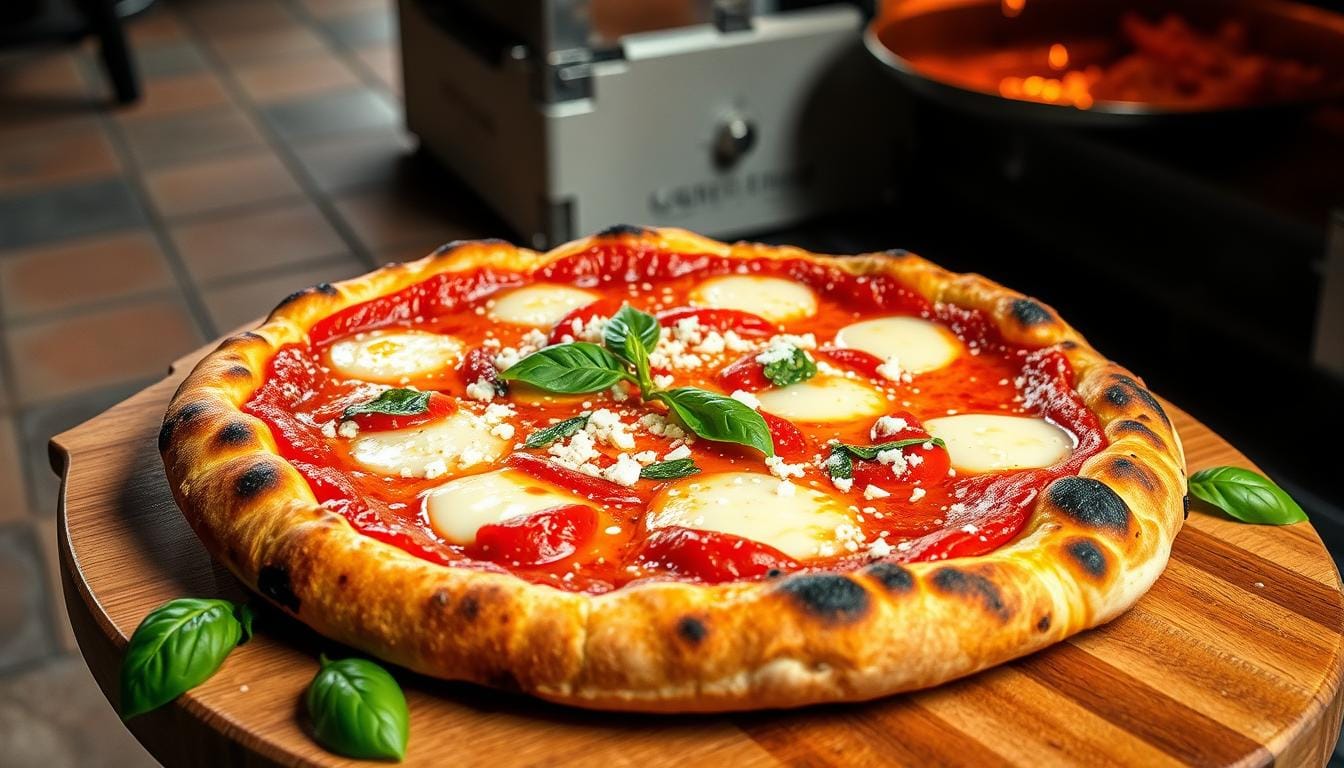Imagine the smell of fresh dough and ripe tomatoes filling the air. The sounds of laughter and conversation add to the magic. Authentic Italian pizza is more than a meal; it’s a cultural experience that brings people together.
It creates memories that last long after the last slice is gone. Your journey to master this dish will take you through its rich history. You’ll learn old techniques that have perfected pizza making.
As you explore traditional pizza, you’ll see it’s more than a recipe. It’s a way to connect with Italian craftsmanship for generations. You’ll get to recreate flavors that have delighted people for centuries. Let’s discover what makes Italian pizza special and how to bring it to your kitchen.
Key Takeaways
- Understanding the cultural roots enriches your pizza-making experience.
- Authenticity lies in choosing quality ingredients for traditional pizza.
- Homemade pizza allows for creativity while honoring classic techniques.
- Mastering dough preparation is key to perfecting Italian pizza.
- Every pizza tells a story, connecting the past with present-day gatherings.
The Rich History of Italian Pizza
The story of pizza spans centuries, deeply rooted in Italian food culture. It shows how a simple dish became a worldwide favorite. This tale starts in Naples, where pizza first became known and loved by the working class.
Origins in Naples
Neapolitan pizza, famous for its true taste, began in the late 1700s. It used simple ingredients like tomatoes, mozzarella, and basil. At first, it was a street food for workers, but soon, it won over the nobility too.
It became more than just food; it became a symbol of Italian cooking.
Evolution Across Regions
Pizza spread across Italy, changing with each region. From thick Sicilian pies to Roman’s crispy ones, each area added its own twist. This shows how pizza’s flavors and styles grew, reflecting Italy’s rich food heritage.
Essential Ingredients for Authentic Italian Pizza
Making authentic Italian pizza means using only the best ingredients. Each part adds to the pizza’s taste, starting with the dough. We’ll explore the key ingredients for a delicious, true-to-style pizza.
Quality Dough Basics
The dough is the heart of a great pizza. It’s made from flour, water, yeast, and salt. This mix creates a soft, stretchy dough perfect for toppings.
Choosing the right flour is important. High-protein flour makes the dough chewy and strong. A well-made dough is key for a perfect crust.
The Role of San Marzano Tomatoes
Every Italian pizza needs a rich tomato sauce. San Marzano tomatoes are the best choice. They’re sweet and have low acidity.
When crushed, they make a vibrant sauce that boosts your pizza’s flavor. Using San Marzano tomatoes adds authenticity and enhances your pizza’s taste.
Fior di Latte Mozzarella Explained
The cheese you choose is critical. Fior di Latte mozzarella, from fresh cow’s milk, is the classic choice. It melts well and stretches beautifully.
Its mild taste lets the tomato sauce shine. It also adds a creamy texture to each slice. Fior di Latte mozzarella is a must for authentic pizza.

Classic Italian Pizza Dough Styles
Exploring the different pizza dough styles can really enhance your cooking skills. Italy is home to many unique pizza-making traditions. Napoletana and Roman pizzas are two standout examples, each with its own special way of making dough and texture.
Napoletana and Its Characteristics
Napoletana pizza has a soft, chewy crust made from top-notch flour and water. It’s fermented for a long time, which adds deep flavors. Cooked in a wood-fired oven, it gets a crispy outside and a soft inside.
Some key features of Napoletana pizza include:
- A thickness of about 0.5 cm.
- Soft interior with a slightly crispy exterior.
- Classic toppings like San Marzano tomatoes, fresh mozzarella, and basil.
Roman Styles of Pizza Dough
Roman pizza, on the other hand, is known for its crispy texture. This comes from a special dough-making method. The dough is rolled out thin and has more water, making it light and airy.
Roman pizza comes in different forms, like:
- Pizza al Taglio, which is rectangular and cut into slices.
- Pizza Romana, known for its base that is both crunchy and airy.

Both Napoletana and Roman pizzas show the beauty of Italian cooking and culture. Learning about these styles can improve your pizza-making skills and deepen your understanding of Italian food.
How to Make Authentic Italian Pizza at Home
Making pizza at home is a fun and rewarding experience. Focus on making great dough and using the right oven techniques. This guide will show you how to make a delicious pizza in your kitchen.
Preparing the Perfect Dough
Start with the dough to make a great pizza. Use quality ingredients and the right techniques. Here’s what you need:
- Flour (preferably Tipo ’00’ flour for authenticity)
- Water at room temperature
- Fresh yeast or active dry yeast
- Salt
Knead the dough until it’s smooth and elastic. Let it rise in a warm place, covered, for at least an hour. This step is key for flavor.
Shaping and Topping Your Pizza
Once the dough has risen, shape it. Lightly flour your work surface and stretch the dough into a round. Don’t use a rolling pin to avoid deflating the dough. Place the dough on a pizza peel or baking sheet.
Now, add your toppings. Keep it simple with:
- San Marzano tomato sauce
- Fior di Latte mozzarella
- Fresh basil leaves
- Drizzle of extra virgin olive oil
Remember, less is more to keep the pizza authentic.
Oven Techniques for Best Results
Oven techniques are key to a great pizza. Preheat your oven to 500°F (260°C). If using a pizza stone or steel, place it in the oven for at least 30 minutes before baking.
Slide your pizza onto the preheated surface and bake for 8 to 10 minutes. Watch closely; it’s done when the crust is golden and the cheese is bubbly.

Italian Pizza: Understanding Toppings and Techniques
Making Italian pizza is more than just dough and sauce. It’s about choosing the right toppings. These should be fresh and in season. Using local produce makes your pizzas vibrant and full of flavor, just like they should be.
Every topping you pick adds to the pizza’s taste. It’s all about finding the right mix for a perfect Italian pizza.
Fresh and Seasonal Ingredients
Using fresh, seasonal ingredients makes your pizza special. These toppings bring strong flavors and show off the region’s best. They change with the seasons, so you can always try something new.
For example, summer tomatoes or fall mushrooms add a unique twist. They make your pizza not just tasty but also creative.
Balancing Flavors for Authentic Taste
Getting the flavors right is key when picking toppings. Think about how much sauce and cheese you use, and how toppings work together. Mixing spicy salami with creamy mozzarella or tangy arugula with sweet tomatoes is a great idea.
This balance shows off your pizza-making skills. It makes every bite a joy to eat.
The Allure of Wood-Fired Pizza
Wood-fired pizza is known for its amazing taste and texture. This cooking method is rich in tradition. It gives pizzas a special flavor that makes them stand out.
Using a wood-fired oven can change how you cook. It’s great for big gatherings or cozy nights at home.
Benefits of Wood-Fired Cooking
Wood-fired ovens can get very hot, between 800 to 900 degrees Fahrenheit. This heat makes the crust perfectly charred. It also adds a smoky flavor to the pizza.
This cooking method is quick. It makes the crust crunchy on the outside and soft on the inside.
Setting Up Your Own Wood-Fired Oven
Want to make your home feel like a pizzeria? Building your own wood-fired oven is a fun project. Here’s what you need to do:
- Find a good spot with enough room and air.
- Pick a quality oven kit or build one with firebricks.
- Make sure it’s well-insulated to keep the heat in.
- Get good wood for the best taste.
- Think about adding a chimney for better airflow.
With the right tools and effort, you can make wood-fired pizza at home. It’s a taste of Italy in your backyard.
| Feature | Wood-Fired Oven | Conventional Oven |
|---|---|---|
| Cooking Temperature | 800-900°F | 450-500°F |
| Flavor Profile | Smoky, charred crust | Traditional, softer crust |
| Baking Time | 1-3 minutes | 10-15 minutes |
| Setup Complexity | Moderate to high | Low |
Knowing these differences helps you see why wood-fired pizza is special. It also inspires you to improve your pizza-making skills at home.
Exploring Classic Italian Pizza Varieties
Italian pizza offers a wide range of classic varieties, each with its own taste and ingredients. The Margherita pizza is a favorite, showing what real Italian pizza is all about. You’ll also find other notable types that add to Italy’s rich pizza heritage.
Margherita Pizza: A Timeless Favorite
Margherita pizza is a true Italian classic. It comes from Naples and is loved for its simple yet perfect ingredients. It’s topped with San Marzano tomatoes, mozzarella, and basil, creating a perfect mix of taste and freshness.
The colors of the pizza, red, white, and green, remind us of the Italian flag. This adds to its cultural importance.
Other Notable Varieties
There’s more to Italian pizza than Margherita. Here are a few other favorites:
- Diavola: Known for its spicy salami and slightly smoky flavor.
- Quattro Formaggi: A cheese lover’s paradise with four different cheeses, often including Gorgonzola, Mozzarella, and Parmigiano.
- Capricciosa: A mix of artichokes, ham, mushrooms, and olives, showing Italy’s love for unique combinations.
These pizzas not only add to your pizza collection but also show the variety and richness of Italian cuisine.
| Pizza Type | Main Ingredients | Flavor Profile |
|---|---|---|
| Margherita Pizza | San Marzano tomatoes, Fior di Latte mozzarella, basil | Fresh and balanced |
| Diavola | Spicy salami, mozzarella, tomatoes | Bold and spicy |
| Quattro Formaggi | Multiple cheeses (Gorgonzola, Mozzarella, etc.) | Rich and creamy |
| Capricciosa | Artichokes, ham, mushrooms, olives | Eclectic and savory |
Final Thoughts on Mastering Italian Pizza
Learning to make Italian pizza is more than a skill. It’s a journey into Italy’s rich culinary world. Every step you take in learning pizza-making techniques shows your appreciation for the art and culture behind it. From choosing the best ingredients to mastering the dough and toppings, each part is key to making real pizza.
As you keep exploring this tasty cuisine, remember that there’s always more to learn. You might find a new topping mix or a technique to make your pizza even better. This love for flavors is at the heart of Italian cooking, where passion and pride shine in every dish.
Your hard work in mastering Italian pizza will not only please your taste buds. It will also connect you to a culture that values family, community, and the joy of sharing meals. Let your kitchen be a place where you can show your creativity and love for Italian food.
Conclusion
This article is a complete guide for those wanting to try authentic Italian pizza. It covers the history and key ingredients that make it special. Now, you know how to improve your pizza-making skills.
Learning about quality ingredients and traditional methods is key. It helps you make pizzas that are unforgettable. You’ll get better at making pizza as you practice.
When you make pizza, you get to try different techniques. This makes your pizza taste and feel better. It’s fun to learn and enjoy making pizza.
Remember, making authentic Italian pizza is more than just following a recipe. It’s about passion, tradition, and sharing meals with others. So, get your ingredients ready, invite friends over, and start making your own Italian pizza.

